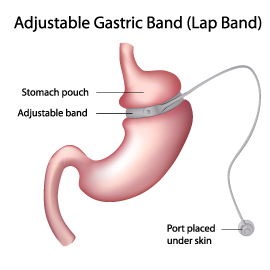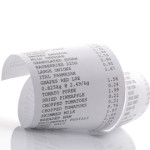
Once the most popular weight loss surgery in the world, LAP-BAND surgery has become a specialty option that is rarely the first choice for surgical weight loss.
The LAP-BAND System and the REALIZE Adjustable Gastric Band are the only two laparoscopic adjustable gastric banding procedures approved for use in the United States. LAP-BAND was the first to be approved for use and may be a more familiar option for patients and some surgeons.
The LAP-BAND consists of a silicone ring that is placed at the top of the stomach. The ring is secured by suturing part of the stomach wall across the front of the band. The ring is then connected by tubing to an access port placed underneath the skin in the abdomen. The silicone ring contains an inner balloon that is inflated with fluid injected into the access port, tightening the ring around the top portion of the stomach.
LAP-BAND placement is almost always performed through laparoscopic surgery while the patient is under general anesthesia. The procedure only requires a few small keyhole incisions to insert, place, and secure the band, tubing, and access port. It’s a less invasive procedure than other bariatric surgeries and doesn’t require any part of the digestive system to be cut, stapled, or removed. No part of the digestive tract is bypassed, which reduces absorption and malnutrition problems often associated with other medical weight loss procedures.
Although the LAP-BAND doesn’t actually reduce the size of the stomach, tightening the silicone ring creates a pouch at the top of the stomach. This pouch can usually hold about 4 ounces of food, which is much less than what a full-sized stomach can accommodate. A properly placed and tightened ring will prevent food from moving down into the rest of the stomach until it has been partially digested, significantly reducing the amount of food and calories that can be consumed in one sitting. The LAP-BAND helps people lose weight because it greatly reduces the patient’s ability to overeat.
It’s important to understand that losing weight with LAP-BAND requires more than a one-time procedure. After the initial placement of the LAP-BAND, follow-up appointments are necessary to adjust the tightness of the ring. Your physician will inject fluid into the access port to make the ring tighter and reduce the amount of food you can eat, or remove fluid to loosen the ring if you’re not able to eat enough. Communication with your medical team is vital to the success of the LAP-BAND procedure.
Although the LAP-BAND will help you feel full on less food, there are some habits you may still need to change after surgery in order to lose a significant amount of weight. For example, the LAP-BAND does not work to reduce the amount of liquids you consume. The ring is mainly responsible for preventing solid foods from passing into the lower portion of the stomach, so it’s important to avoid taking in too many liquid calories. Soda and alcoholic beverages, for example, can pass easily through the LAP-BAND and sabotage your weight loss efforts.


